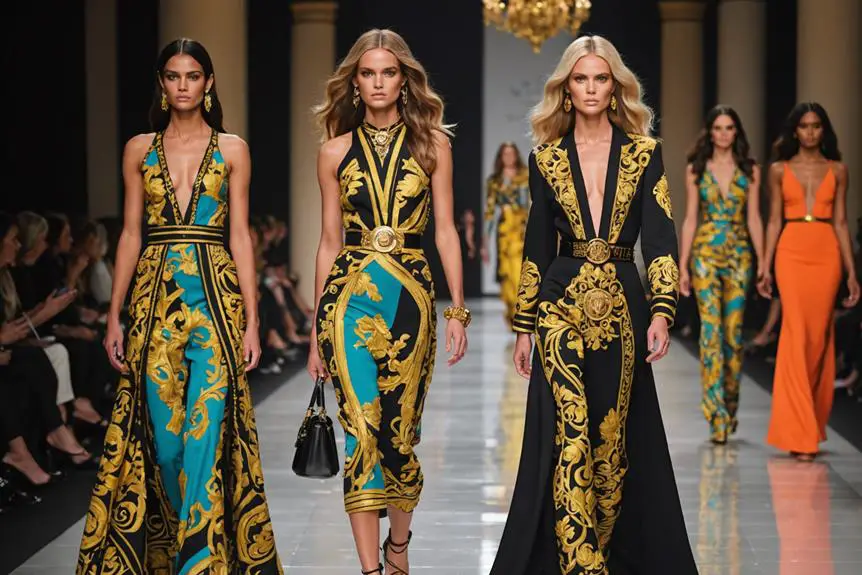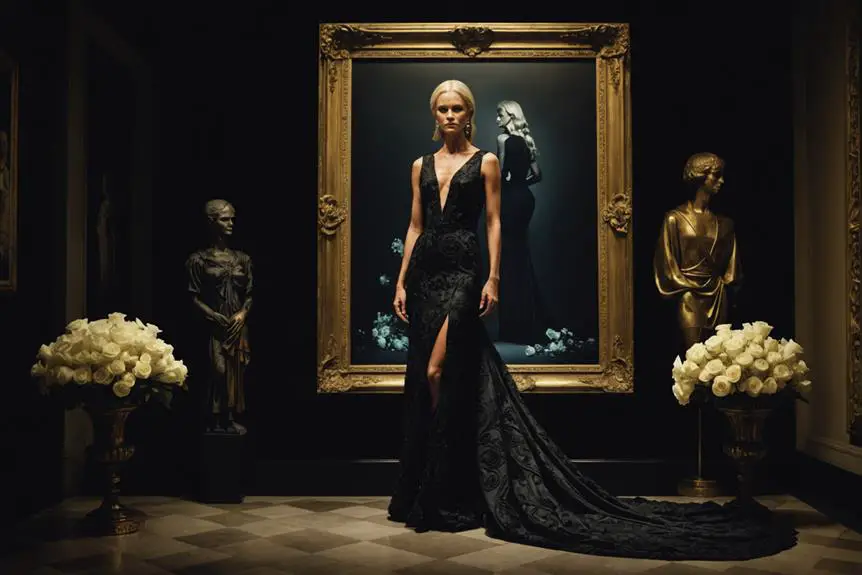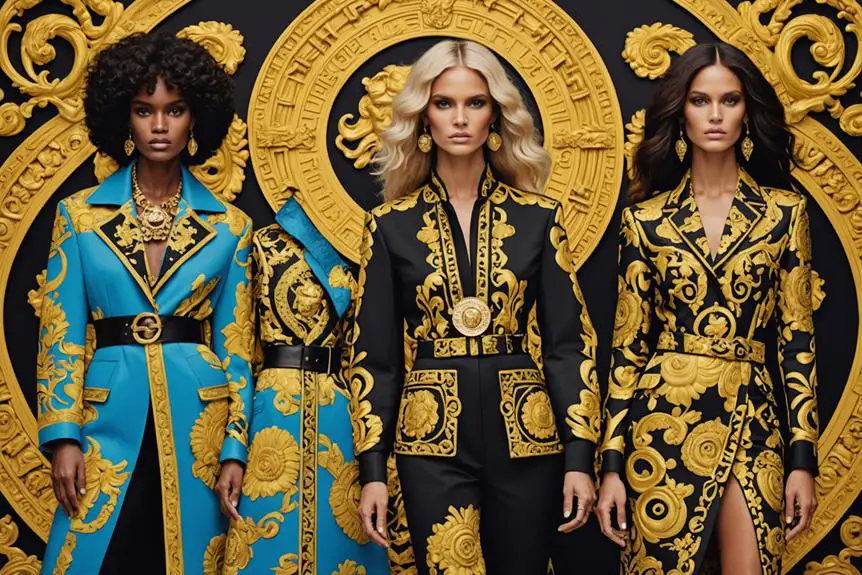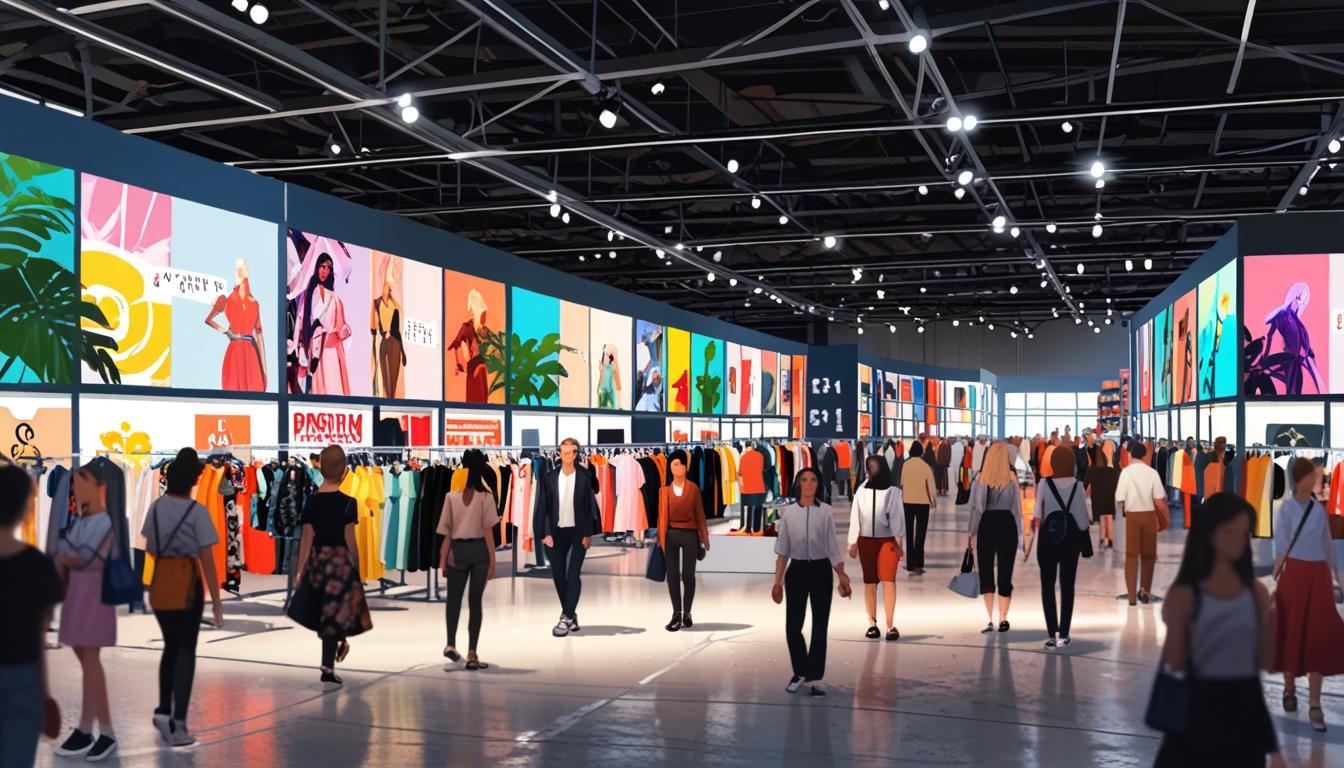When you think of Gianni Versace, you envision a pioneering force who transformed the landscape of high fashion. Hailing from Italy, he began his journey in fashion at just nine years old, ultimately creating a brand that seamlessly merged art, rock culture, and sensuality. His daring use of color and unforgettable designs, such as the iconic safety pin dress, left a lasting impact on the industry. Following his untimely assassination in 1997, his sister Donatella stepped up to lead the brand, preserving its core identity while infusing contemporary relevance. Versace's influence remains a source of inspiration for emerging designers, profoundly impacting how fashion expresses identity and culture today. There is an abundance of rich history and innovation to uncover regarding this legendary fashion designer.
Who Was Gianni Versace?

Gianni Versace was a renowned fashion designer and a revolutionary figure in the fashion industry. Born in Reggio di Calabria, Italy, in 1946, he launched his first clothing line in Milan in 1978, quickly gaining recognition for his glamorous and bold designs. His brilliance is evident in creations like the iconic siren dresses and the pioneering use of innovative materials such as aluminum mesh and neo-couture laser technology. Versace transcended traditional fashion design; he created cultural phenomena, dressing high-profile celebrities including Madonna and Princess Diana, and seamlessly blending fashion with celebrity culture throughout the 1980s and 90s.
Tragically, his life was cut short when he was assassinated outside his home in South Beach, Florida, on July 15, 1997. This shocking event sent shockwaves through the fashion world, creating a void that was hard to fill. Despite his untimely passing, Gianni Versace's legacy endures, marked by his signature bold colors, striking prints, and an unmistakable sense of luxury. His family has continued to uphold his vision, ensuring that the Versace brand remains a prominent symbol of high fashion, forever influenced by the revolutionary spirit he embodied.
Early Life and Career
Growing up in Reggio di Calabria, Italy, in a household rich in creativity, Gianni Versace's early exposure to fashion was profoundly influenced by his mother's dressmaking business, which played a crucial role in shaping his artistic vision. By the age of nine, he had already crafted his first dress, demonstrating a remarkable talent that would later define his illustrious career. After completing high school, Gianni collaborated closely with his mother, refining his skills and gaining a deep understanding of the nuances of design.
In 1972, in pursuit of greater opportunities, he relocated to Milan, a vibrant hub of fashion. His freelance work thrived, and by 1978, he introduced his inaugural ready-to-wear women's collection, laying a strong foundation for what would become his iconic brand. The support of the Versace family was instrumental in this endeavor; Gianni co-founded the fashion house with his brother Santo and sister Donatella. While Santo took charge of financial management, Donatella emerged as both his muse and vice president, fostering a dynamic familial collaboration.
A pivotal moment arrived in 1989 when Gianni unveiled his first haute couture collection with Atelier Versace. This bold venture not only cemented his status in the realm of high fashion but also showcased his distinctive fusion of art and glamour, paving the way for his future innovations that would leave an indelible mark on the industry.
The Versace Style

Versace's designs have transformed the fashion landscape, showcasing a fearless fusion of glamour and audacity that has enchanted audiences globally. As you delve into the Versace style, you'll quickly recognize its distinctiveness compared to contemporaries like Giorgio Armani, marked by vibrant colors and eclectic prints. This fashion house transcends the realm of haute couture; it makes a bold statement.
At the core of Versace's essence is the iconic Medusa head, a symbol of allure and power that runs through his collections. His renowned siren dresses, characterized by their form-fitting silhouettes and daring cuts, redefine femininity, celebrating the body as a canvas for self-expression. Versace's innovative use of materials, such as aluminum mesh and neo-couture laser technology, challenges the conventions of traditional fashion design.
Provocative creations like bondage dresses and safety pin dresses often ignited controversy, yet they also defied societal norms, ushering in a new era of fearless fashion. When you think of Versace, you're not merely contemplating clothing; you're engaging with a philosophy that champions individuality and empowerment, solidifying the brand's status as a timeless icon in the fashion world.
Iconic Designs and Collaborations
The world of high fashion is often defined by its iconic designs and memorable collaborations, and few names resonate as powerfully as that of the renowned designer Versace. One cannot discuss his legacy without mentioning the daring "safety pin" dress, famously donned by Elizabeth Hurley in 1994. This striking design not only showcased his exceptional talent for blending glamour with provocative elements but also solidified his place in fashion history. In his Atelier Versace Haute Couture Spring 1997 collection, the intricate craftsmanship marked a significant moment, showcasing both the end of an era and his innovative spirit.
Versace's collaborations with celebrated photographers like Helmut Newton and Bruce Weber were equally pivotal. Their striking visuals helped establish Versace's bold advertising campaigns, transforming his creations into cultural phenomena. The designer's innovative use of materials, such as aluminum mesh, combined with neo-couture laser technology, pushed the boundaries of fashion design. Additionally, the recurring Medusa head motif in his collections became a signature symbol representing allure and confidence. Together, these iconic designs and collaborations not only defined Versace's unique aesthetic but also left an indelible mark on the fashion industry.
Impact of Gianni Versace's Death

Tragedy shook the fashion world on July 15, 1997, when renowned designer Gianni Versace was murdered outside his Miami villa. His assassination left an enduring impact that reverberated throughout the industry, stunning fans and fellow designers alike. The shocking event created a significant emotional and leadership void within the Versace fashion house, prompting his sister, Donatella Versace, to step in as chief creative officer. She took on the monumental task of upholding the family's legacy during a tumultuous time, ensuring that Gianni's vision of empowering women through bold and sensual fashion would not fade away.
In the aftermath of this tragedy, the fashion industry grappled with heightened awareness of safety and mental health issues, exposing vulnerabilities in the celebrity culture that Gianni had significantly shaped. His death marked a pivotal turning point, sparking important discussions about the pressures faced by designers and celebrities in an unforgiving spotlight.
While the Versace brand initially faced a decline in the wake of Gianni's death, Donatella's creative vision led to a revival. She skillfully blended her unique creativity with Gianni's iconic styles, ensuring that his influence continued to resonate in the fashion world. Media portrayals, particularly in series like "American Crime Story," have played a crucial role in keeping his legacy alive, reigniting interest in his groundbreaking contributions to both fashion and culture. Gianni Versace's impact continues to serve as a reminder of the fragility of life and the enduring power of creativity.
Donatella Versace's Leadership
Following the tragic death of Gianni Versace, Donatella Versace assumed the role of chief creative officer with an unwavering commitment to honoring her brother's legacy. Within just six months, she unveiled her first collection at Milan Fashion Week, demonstrating her remarkable ability to adapt under tremendous pressure. Donatella inherited not only the brand but also the crucial task of transforming it. Her leadership emerged at a critical juncture when the company was experiencing declining profits, and she adeptly navigated these challenges, drawing on the brand's rich history and vintage aesthetics to resonate with both loyal customers and new audiences.
Under her guidance, the Versace brand preserved its iconic status while evolving its visual identity. This transformation is evident in several key aspects:
- Balancing Legacy and Modernity: Donatella masterfully intertwines tributes to Gianni's designs with contemporary fashion trends, captivating a new generation of fashion enthusiasts.
- Emotional Resilience: She faced the emotional hurdles of her brother's passing with remarkable strength and unwavering focus.
- Family Involvement: With her daughter Allegra holding a significant stake in the company, the family's dedication to the brand remains robust.
- Recognition in Fashion: Donatella has received numerous accolades for her contributions, affirming her prowess as a leader in the fashion industry.
Through her visionary approach, Donatella continues to shape Versace's legacy while steering the brand confidently into the future.
Legacy and Cultural Impact

Gianni Versace's impact on the fashion world extends far beyond his lifetime, leaving an indelible mark that resonates through contemporary culture. He revolutionized fashion by boldly merging rock culture, art, and sexuality, which not only shaped modern identity but also encouraged the integration of street fashion into high fashion. With an $807 million business and 130 boutiques worldwide, Gianni Versace's legacy continues to thrive today.
His tragic death in 1997 was a pivotal moment, evoking deep mourning among industry leaders like Anna Wintour and reshaping public consciousness around celebrity culture. This unique blend of fashion and fame crafted a narrative that continues to captivate audiences. The media's ongoing fascination is evident in portrayals like the acclaimed series "American Crime Story," which highlights his contributions to the fashion landscape.
Versace's legacy is preserved through his family, particularly Donatella Versace, who honors his innovative spirit and creative vision. The cultural impact of Gianni Versace's designs remains influential, reminding us that fashion is not merely about clothing but also about the stories, emotions, and identities we choose to express. His work continues to inspire new generations of designers, ensuring that the essence of Versace will endure in the ever-evolving tapestry of fashion.
The Versace Brand Today
Today, the Versace brand stands as a vibrant embodiment of its founder's visionary spirit, seamlessly merging luxury with contemporary relevance. Renowned for its bold colors and sensual cuts, alongside its rich heritage, the brand continues to innovate under the creative direction of Donatella Versace. This dynamic approach has solidified a robust global presence, with 230 boutiques and 638 licensed stores worldwide. By employing key features for identifying vintage, Versace not only pays homage to its history but also captivates a modern audience eager to connect with the brand's legacy.
Here are four key elements that define the Versace brand today:
- Diverse Offerings: Versace presents ready-to-wear collections for women, men, and children, alongside a range of accessories, fragrances, and home goods.
- Cultural Fusion: The brand expertly intertwines classical Italian traditions with modern innovation, crafting pieces that resonate with today's fashion consumers.
- Engagement Strategies: Versace actively connects with customers through tailored promotions and a strong social media presence, nurturing brand loyalty and interaction.
- Contemporary Aesthetics: The brand's designs showcase an audacious blend of bold prints and colors, appealing to a wide audience that values both luxury and originality.
In this manner, the Versace brand not only honors its past but also confidently strides into the future, enchanting new generations.
Frequently Asked Questions
What Type of Designer Was Gianni Versace?
Gianni Versace was a bold innovator in the fashion world, renowned for blending vibrant colors and daring designs. His work encouraged self-expression and individuality, merging art and culture to create a unique aesthetic that redefined contemporary fashion and celebrity culture. Versace's designs often featured striking patterns and luxurious materials, making a significant impact on the fashion industry and influencing countless designers who followed in his footsteps.
Who Inherited Gianni Versace's Fortune?
You'll find that Gianni Versace's fortune primarily went to his niece Allegra, who inherited a 50% stake in the brand at just 11 years old. His siblings Donatella and Santo also played vital roles in preserving and promoting the legacy of the iconic fashion house.
What Are Some Interesting Facts About Gianni Versace?
Gianni Versace's life is a captivating tale; he transformed the fashion industry by merging celebrity culture with daring designs. His renowned Medusa emblem represents allure and seduction, while his untimely death left a profound impact on the world, solidifying his unforgettable legacy in fashion history.
Who Is the Lead Designer of Versace?
You're looking for the lead designer of Versace, and that's Donatella Versace. Since 1997, she's skillfully blended her brother Gianni's iconic vision with modern trends, ensuring the brand's enduring relevance and innovative spirit in fashion. Her creative direction has not only maintained the legacy of the brand but has also pushed boundaries, making Versace a symbol of boldness and luxury in the fashion industry.




Your article helped me a lot, is there any more related content? Thanks! https://accounts.binance.com/tr/register?ref=W0BCQMF1
Your point of view caught my eye and was very interesting. Thanks. I have a question for you.
Your article helped me a lot, is there any more related content? Thanks!
Your article helped me a lot, is there any more related content? Thanks! https://www.binance.com/ro/register?ref=HX1JLA6Z